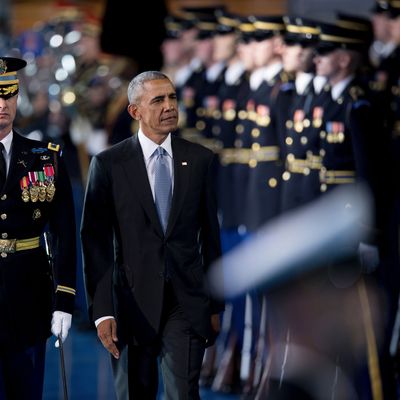
In one of his first acts as commander-in-chief, Donald Trump ordered his top military advisers to conduct a 30-day review of America’s strategy for defeating ISIS.
Given that precise timeline — and Trump’s past promises that he actually had a secret plan for defeating the terrorist group ready to go — one might have expected the White House to unveil its vision for combating ISIS in late February or early March.
But one would have been wrong. Five months passed before the president even indicated that a new strategy was imminent: On May 21, Trump announced that he would detail his administration’s plan for defeating ISIS “in about two weeks.”
A little over two weeks later, the president revealed that his long-awaited plan was finally, truly almost ready — and he would outline it at a news conference in “two weeks.”
Nearly a month later, we’re still waiting for that news conference.
One can imagine a whole host of reasons for Trump’s procrastination. Perhaps, the administration has been distracted by the alarming developments in North Korea (and/or the special prosecutor’s office). Or maybe gaming out a plan for defeating as singular an enemy as the Islamic State simply takes a lot of time. Or, perhaps, the president just has little interest in telling the public what his military plans are, and says “that’s coming in two weeks” to literally any policy proposal he’s ever asked about.
But the Daily Beast suggests an alternative answer. The outlet notes that U.S. forces have removed 50 top ISIS leaders from the battlefield since Trump took office — down from 80, in the last six months of Obama’s tenure. Further, the militants killed on Trump’s watch have generally been lower-ranking than those targeted by the previous administration.
These facts don’t reflect the inferiority of the Trump administration’s anti-ISIS strategy so much as the sufficiency of the strategy it inherited: The military is simply running out of high-value ISIS targets to kill. Under Obama, the U.S. military was effectively wiping out ISIS’s leadership.
Now, you can’t kill a violent, anti-American ideology by dropping American bombs in the Middle East. And you can’t prevent disaffected, psychologically damaged young men from seeking meaning in acts of spectacular violence. So lone-wolf terrorists provided Trump with plenty to demagogue about in 2016. But to the extent that sheer force can solve a problem like ISIS, the Obama administration’s approach was working just fine:
Trump’s changes to the campaign [against ISIS] so far have been tactical—namely, giving the military more autonomy to strike, including special operators. But the effectiveness of the current Obama-era strategy of attacking ISIS via local forces together with allies calls into question whether there’s a need for more dramatic revision.
That’s presented a dilemma for those working on the Trump anti-ISIS strategy and slowed its public unveiling, U.S. officials tell The Daily Beast. The White House has asked defense officials to come up with new ideas to help brand the Trump campaign as different from its predecessor, according to two U.S. officials and one senior administration official. They spoke on condition of anonymity to discuss the sensitive debates.
To review, the Trump administration’s vision for fighting ISIS differs from its predecessor’s in two key ways:
1) This White House believes in giving greater autonomy to its military commanders, thereby enabling them to make the best tactical decisions, unencumbered by petty political concerns.
2) It also believes in asking its generals to alter their strategic plans, not because the administration doubts their military efficacy, but solely because it finds them difficult to “brand.”
Can’t you just feel America being made safe again?






























